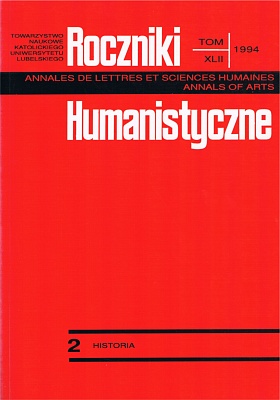Abbatia de Bresca in the 12th and 13th Centuries and Some Problems of the Most Ancient History of the Brzesko Group of the Polish Premonstratensians
Abstract
The paper discusses the issues connected with the setting-up of the Premonstratensian monasteries which was eventually led in the 13th c. by the abbey in Brzesko. The order of Premonstratensians roots in Poland in the end of the 12th. c. and the beginning of the 13th c.. This was done mainly by affiliating the monasteries which belonged earlier to other branches of St Augustine's canon. In like manner the group of the monasteries in question was being formed. It is difficult to fix the time of circumstances in which the monasteries of the Brzesko group were founded; nor is it easy to determine the time of their affiliation to the Premonstratensian order. This difficulty is due to the scarce and unclear sources. In the paper the author confronts the findings of his earlier researches (his publications and the unpublished parts of his doctoral dissertation) with the findings of Jerzy Rajman. He emphasizes the correlation between some agreements in both works, discusses other theses put forward by Rajman and pinpoints that the problem is open to further research. First he depicts the difficulties which arise from the complicated character of the subject under study and from the specific character of the sources. He defends his prior standpoints as to the origins of the monastery in Brzesko and Zwierzyniec. He draws the foundation of these monasteries as far back as the 1140s. He suggest a many-phase process of their integration with the Premonstratensian order, a process which is more complicated than Rajman thinks. He reveals the phases of the foundation and reforms which took place within the order. In the case of the outposts of the Brzesko group we find behind these reforms such people as Henryk Zdik, the bishop of Ołomuniec, comes Jaksa, Helena - the wife of Casimir the Just - and Wojsława, the sister of bl. Hroznata (as to the role which these two women played, he emphasizes the significance of Rajman's findings), Cyprian, the bishop of Wrocław, Wit, the bishop of Płock and Iwon Odrowąż, the bishop of Krakow. Cyprian, the bishop who belonged to the Premonstratensian order and bishop Iwon who acted on behalf of the order and was credited with giving the final shape to the Polish cyrkaria of the Premonstratensian order. The links between the monasteries in Czech and Morawy were a permanent element of the reforms. The author analyzes the particular property and legal situations in which some of the monasteries were before they were affiliated into the order of Premonstratensians. We mean here the type of monastery which made the sovereign's property and was linked to a particular unit of the state administration (to the abbey in Brzesko which was a monastery of a small castellani) and the "family" monastery which participated in the estate of its founders and protectors. Finally, there was the case of the monasteries in Witów and Busk. In discussing them the author based himself first of all on the unpublished materials.
Copyright (c) 1994 Roczniki Humanistyczne

This work is licensed under a Creative Commons Attribution-NonCommercial-NoDerivatives 4.0 International License.





